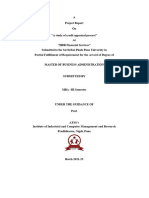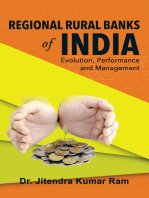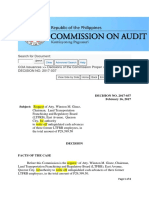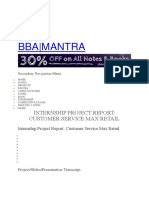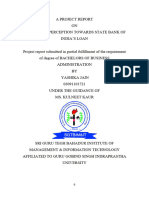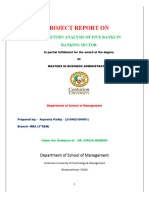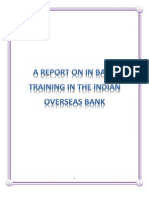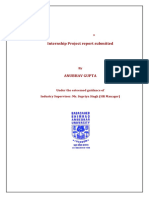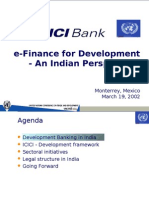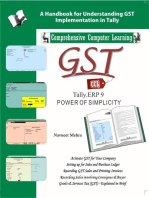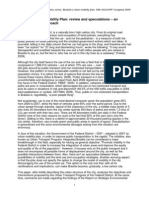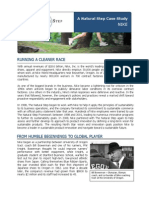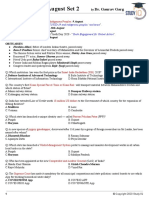A Study of State Bank of India
A Study of State Bank of India
Uploaded by
Mariya MithaiwalaCopyright:
Available Formats
A Study of State Bank of India
A Study of State Bank of India
Uploaded by
Mariya MithaiwalaOriginal Description:
Copyright
Available Formats
Share this document
Did you find this document useful?
Is this content inappropriate?
Copyright:
Available Formats
A Study of State Bank of India
A Study of State Bank of India
Uploaded by
Mariya MithaiwalaCopyright:
Available Formats
A STUDY OF MARKETING TECHNIQUES
ON STATE BANK OF INDIA
UNIVERSITY OF MUMBAI
LALA LAJPAT RAI COLLEGE OF COMMERCE AND ECNOMICS
MAHALAXMI, MUMBAI 400034
SUBMITTED BY:
Ms. MARIYA MITHAIWALA
ROLL NO.1314329
TYBBI SEMESTER V
PROJECT GUIDE:
PROF VAIDEHI KAMATH
YEAR OF SUBMISSION
2015-16
CERTIFICATE
STUDY OF MARKETING TECHNIQUES ON STATE BANK OF
INDIA
Dr. Vaidehi Kamath, hereby certify that MS. MARIYA MITHAIWALA from TYBBI of Lala
Lajpatrai College of Commerce and Economics has successfully completed the Research Project
on Banking titled A STUDY OF MARKETING TECHNIQUES ON STATE BANK OF
INDIA in semester V of the academic year 2015-16.
The information is submitted is here is true and original to the best of my knowledge.
________________________
_______________________
Signature of External Examiner
Signature of Internal Examiner
_________________________
____________________
Signature of the Project Guide
Signature of Principal
Date of Submission: 2ndSeptember, 2015
DECLARATION
[Type text]
Page 2
STUDY OF MARKETING TECHNIQUES ON STATE BANK OF
INDIA
I, MS. MARIYA MITHAIWALA from TYBBI of Lala Lajpatrai College of Commerce and
Economics, hereby declare that I have completed this Research Project on Banking titled A
STUDY OF MARKETING TECHNIQUES ON STATE BANK OF INDIA in semester V of the
academic year 2015-21016.
The information provided by me here is true and original and to the best of my knowledge.
Date: _____________________
_________________________
Students Signature
[Type text]
Page 3
STUDY OF MARKETING TECHNIQUES ON STATE BANK OF
INDIA
ACKNOWLEDGEMENT
With great pleasure we thank Mrs.Vaidehi Kamath. Professor of LALA LAJPATRAI COLLEGE
OF COMMERCE AND ECONOMICS for being an inspiration in the completion of this project.
We thank for her invaluable help provided during the completion of this project. We also thank
her for providing us guidance and numerous suggestion throughout entire duration of the project.
With it this project would not have materialized.
We express our deep gratitude to my entire college friend and my family members whose efforts
and creativity helped us in giving the final structure to the project work.
We are also thankful to all those seen and unseen hands and heads, which have been of help in
the completion of this project work.
[Type text]
Page 4
STUDY OF MARKETING TECHNIQUES ON STATE BANK OF
INDIA
EXECUTIVE SUMMARY
The project is all about banking system and the product provided by the bank to the customer.
The project provide analysis on the factors which influence customers choice while selecting
bank product and the problems faced by banks to retain their customer. In order to know this
factors and problems faced by customers a survey was conducted. It was limited only till south
Mumbai which can also be extended further, the survey was conducted within 10 people having
a bank account mostly in SBI Bank. Only 8 questions were asked and out of that most of the
questions was related to product provided by the bank.
The project finds that customer is not only satisfied by what type of product is being
provided in India but they expect much more then what is actually being provided. Customers
not excepts safety but also best ways to invest money which needs to be fulfilled. Hence banks
needs to outlook the customer requirements and fulfill them. So in order to retain their customers
bank has to be aware of the needs and requirement of the customers.
The report also investing the fact that the analysis conducted has limitations. The survey
conducted is limited to geographical boundaries of south Mumbai. Only SBI Bank is considered
in the research other banks are not considered.
[Type text]
Page 5
STUDY OF MARKETING TECHNIQUES ON STATE BANK OF
INDIA
INDEX
CHAPTER NO.
PARTICULAR
1.
INTRODUCTION
1.1OBJECTIVE OF STUDY
1.2 SCOPE OF STUDY
1.3 RESEARCH METHODOLOGY
1.4 COLLECTION OF DATA
1.5 RESEARCH LIMITATION
SBI BANK
2.1 INTRODUCTION
2.2 DEFINATIONS
2.3 FEATURES
10
2.4 MANAGING FUND
11
2.5 ADVANTAGES
12
2.6 DISADVANTAGES
13
2.7 HISTORY
14
2.8 LEADING COMPANIES
15
2.9 TYPES
16
2.10 INVESTMENTS
17
2.11 EXPENSES
18
2.
[Type text]
PAGE NO.
Page 6
STUDY OF MARKETING TECHNIQUES ON STATE BANK OF
INDIA
2.12 CONTROVERY
2.13 LIST OF SBI BANK IN INDIA
3.
COMPANY PROFILE
19
20
21
3.1 INTRODUCTION
4.
[Type text]
3.2 MANAGEMENT
22
3.3 HISTORY
23
3.4 OBJECTIVE
24
3.5 ACQUISITION
25
3.6 BUSINESS
26
3.7 COMPETITORS
27
3.8 STRENGTH/OPPORTUNITIES
AND WEAKNESS/THREATS
28
3.9 DIFFERENT PRODUCT
29
3.10 AWARDS
30
MARKETING TECHNIQUES ON
SBI BANK
31
4.1 INTRODUCTION
32
4.2 KEY INFORMATION
33
4.3 7Ps OF SBI
34
ANALYSIS AND INTERPRITATION
39
CONLUSION
49
Page 7
STUDY OF MARKETING TECHNIQUES ON STATE BANK OF
INDIA
BIBLOGRAPHY
50
CHAPTER 1
INTRODUCTION
State Bank of India is an Indian multinational, Public Sector banking and financial
services company. It is a government-owned corporation with its headquarters in Mumbai,
Maharashtra and also its corporate office in Mumbai, Maharashtra. As of December 2013, it had
assets of US$388 billion and 17,000 branches, including 190 foreign offices, making it the largest
banking and financial services company in India by assets.
State Bank of India is one of the Big Four banks of India, along with Bank of Baroda, Punjab
National Bank and ICICI Bank.
The bank traces its ancestry to British India, through the Imperial Bank of India, to the founding,
in 1806, of the Bank of Calcutta, making it the oldest commercial bank in the Indian
Subcontinent. Bank of Madras merged into the other two "presidency banks" in British
India, Bank of Calcutta and Bank of Bombay, to form the Imperial Bank of India, which in turn
became the State Bank of India. Government of India owned the Imperial Bank of India in 1955,
with Reserve Bank of India (India's Central Bank) taking a 60% stake, and renamed it the State
Bank of India. In 2008, the government took over the stake held by the Reserve Bank of India.
State Bank of India is a regional banking behemoth and has 20% Market share in deposits and
loans among Indian commercial banks.
SBIs non- banking subsidiaries/joint ventures are market leaders in their respective areas and
provide wide ranging services, which include life insurance, merchant banking, mutual funds,
credit cards, factoring services, security trading and primary dealership, making the SBI Group a
truly large financial supermarket and Indias financial icon. SBI has arrangements with over
1500 various international / local banks to exchange financial messages through SWIFT in all
business centre of the world to facilitate trade related banking business, reinforced by dedicated
and highly skilled teams of professionals.
[Type text]
Page 8
STUDY OF MARKETING TECHNIQUES ON STATE BANK OF
INDIA
STATE BANK OF INDIA, Antwerp was opened on the 15th July 1983. The branch started
meeting the growing trade between the BENELUX countries and India, with emphasis on the
growing Belgo Indian diamond trade. Today, we have an active trade desk financing a variety of
exports from EU countries. We offer quick and reliable remittance facilities to India and other
SAARC countries at cost-effective rates. We actively participate in global syndications and
facilitate acquisition and mergers of companies in EU region besides meeting the India related
business needs of European companies. A team of committed and motivated staff offer a variety
of services and financial products at competitive pricing.
1.1 OBJECTIVES
1. To promote and develop in India sound and progressive banking principles, practices and
conventions and to contribute to the developments of creative banking.
2. To render assistance and to provide various common services to Members and to the
banking industry.
To develop and implement new ideas and innovations in banking services, operations and
procedures.
To organize co-ordination and co-operation on procedural, legal, technical,
administrative or professional problems and practices of banks and the banking industry.
3. To initiate advance planning for introduction of new systems or services in the banking
industry.
4. To collect, classify and circulate statistical and other information on the structure and
working of the banking system.
5. To act as a clearing house for dissemination and exchange of statistical data, information,
views and opinions on the systems, procedures and practices, and organization and
methods of banks and on the structure, working and operations of the banking system.
[Type text]
Page 9
STUDY OF MARKETING TECHNIQUES ON STATE BANK OF
INDIA
6. To explore, plan, co-ordinate and organize detailed surveys on banking, business,
resources, personnel and management development programmes of banks and the
banking industry.
7. To organize exchange of credit information and opinions, export information or
information and views on any other aspects of interest to banks or the banking industry.
8. To issue periodical newsletters, bulletins or magazines and publish books, pamphlets or
other literature on matters of interest to members and to the banking industry.
9. To issue periodical newsletters, bulletins or magazines and publish
books, pamphlets or other literature on matters of interest to members
and to the banking industry.
10.
To project a good public image of banking as a service industry
and develop good public relations.
1.2 SCOPE OF STUDY
Money is the centre of world economy and Bank works as a central point for
money.
Banking industry is a very growing industry and among all the banks,
particularly SBI is doing very well.
In this time of global recession where the other companies are laying off their
staffs but SBI has recruited more than 20000 employees in the year 2008.
So there is a huge potential for getting jobs in SBI.
The scope of this study is that it will help the further researchers to gain an insight into
the customer minds that what are their perception about public and private sector banks
and how it affects the banking sector.
Research is conducted in south Mumbai.
Research is been carried among 1o people.
Research is being carried on one bank which is SBI.
1.3 RESEARCH METHODOLOGY
[Type text]
Page 10
STUDY OF MARKETING TECHNIQUES ON STATE BANK OF
INDIA
Research methodology is a methodology for collection all sorts of information and data
pertaining to the subject in question. The objective is to examine all the issues involved and
conduct situational analysis. The methodology includes overall research design, sampling
procedure and fieldwork done and finally the analysis procedure. So keeping in view the
nature of requirements of the study to collect all relevant information regarding the
Marketing techniques on SBI Bank, direct personal interview method with structured
questionnaire was adopted for the collection of primary data. Secondary data has been
collected through the various magazine and newspapers and by surfing on internet. And the
guide in college was consulted many times.
[Type text]
Page 11
STUDY OF MARKETING TECHNIQUES ON STATE BANK OF
INDIA
1.4 COLLECTION OF DATA
Data was collected by using main two method i.e. primary data and secondary data.
Primary data
I t c o n s i s t s o f o r i g i n a l i n f o r m a t i o n s c o l l e c t e d f o r specific Purpose.
Primary data for this research, data are collected through a direct source like survey
to obtain the first hand information is others resources are written below.
Survey
Face to face interaction.
Secondary data
The secondary data can be defined as data collected by someone else
for purposes other than solving problem being investigation and previously meant
for another purpose. We used magazines, journals, paper and internet for the
collection of data. It helps us to better determine our problem and formulate an appropriate
research design. It is the data which is collected by others. It is re-used researcher.
The various sources of secondary data are Websites, Newspapers, Magazine, Books and
Journals.
1.5 RESEARCH LIMITATION
First and foremost objective is to find out the reasons for using of Advance Product from
SBI.
To find out the services that bank gave to their customers.
To generate the leads through the survey.
To sort out the prospective leads from which have collected through the survey.
[Type text]
Page 12
STUDY OF MARKETING TECHNIQUES ON STATE BANK OF
INDIA
To build the relationship with the customers and to follow up them, make sure that they
are satisfied with the product.
To maintain good relationship with the corporate employees.
To get more references from the customers and generate new leads by following a chain
process.
To place SBI Advance Product ahead of the competitors.
To make the customer aware of the benefits of the product and convince him to go for
SBI Advance Product.
[Type text]
Page 13
STUDY OF MARKETING TECHNIQUES ON STATE BANK OF
INDIA
SBI BANK
2.1 INTRODUCTION
State Bank of India is Indias largest bank with total assets of US$ 260 billion at September 31,
2009. The Bank has a network of 16,000 branches and about
3000ATMs in India and presence in 32 countries. SBI Bank offers a wide range of banking
products and financial services to corporate and retail customers through a variety of delivery
channels and through its specialized subsidiaries and affiliates in the areas of investment
banking, life and non-life insurance, venture capital and asset management. The Bank currently
has subsidiaries in the United Kingdom, Russia and Canada, branches in United States,
Singapore, Bahrain, Hong Kong, Sri Lanka, Qatar and Dubai International Finance Centre and
representative offices in United Arab Emirates, China, South Africa, Bangladesh, Thailand,
Malaysia and Indonesia .SBI Banks equity shares are listed in India on Bombay Stock Exchange
and the National Stock Exchange of India Limited.
2.2 DEFINATION
A financial institution that has been chartered by a state to provide commercial banking. A state
bank is not the same as a central or reserve bank because those banks are primarily concerned
with influencing a government's monetary policy. In the United States, state banks are not
regulated by the Office of the Comptroller of the Currency (OCC) which is the federal agency
that oversees banks that operate nationally. Some state banks are regulated by the Federal
Reserve, and those that are not are regulated by the Federal Deposit Insurance Corporation
(FDIC).
BREAKING DOWN 'State Bank'
State banks can still be large financial institutions. They are not permitted to expand nationwide
because they do not have a federal charter. State banks may be able to provide more nationwide
services, such as ATMs, by partnering with banks with a broader presence around the country. In
certain states, state banks have more authority than national banks in providing insurance and
investment banking services.
[Type text]
Page 14
STUDY OF MARKETING TECHNIQUES ON STATE BANK OF
INDIA
2.3 FEATURES
Credit Convenience
Credit free period of up to 50 days and extended credit facility with very low interest rate of
2.25% p.m.
Ready Cash
As an SBI Cardholder, you can avail credit card cash withdrawal service from over 1 million
VISA/MasterCard ATMs (Please check the logo on the front of your card before using) across
the globe, including 18,000 ATMs in India. In addition to this, you get access to over 10,000
SBI ATMs across 100 plus cities in India and enjoy up to 100% cash withdraw limit.
Convenient Application Procedure
SBI Advantage Gold Card can be availed on the basis of a Fixed Deposit with State Bank
Group.
Add-on cards - Enhanced Power to your family
You can now conveniently take care of the needs of your loved ones. Your SBI Advantage
Gold Card now lets you apply for add-on cards for your spouse, parents, children or siblings
above the age of 18.
Utility Bill Payment Facility
With the Easy Utility Bill Payment facility from SBI Visa Card you can be rest assured you
will never ever forget paying your utility bills on time. All your utility bills like electricity,
insurance, telephone will get paid before the due date with this facility from SBI Gold Credit
Card.
[Type text]
Page 15
STUDY OF MARKETING TECHNIQUES ON STATE BANK OF
INDIA
Guaranteed peace of mind
Your sense of security is our priority.SBI Card automatically gives you complete peace of
mind with our SBI Card Customer Helpline and 24-hr VISA/MasterCard Global Customer
Assistance Services available across the world in case of any emergency.
2.4 STRUCTURE
The organizational structure of SBI is the functional type. The organization is departmentalized on the basis of
function profile as shown in figures departments like Finance, Securities, Operations, and Planning &
Development. SBI being a public sector bank has a well-defined hierarchy of authority and clearly defined
responsibilities. The Bank follows the predefined rules and procedures in decision-making. (HIERARCHY)
HEIRARCHY OF THE BANKS Chairman Managing director (2)Directors General managers Deputy general
managers Assistant general manager Chief Manager Branch Manager Structure of SBI CHAIRMAN and
MANAGING DIRECTOR .
State Bank of India owns and operates the following subsidiaries and Joint Ventures Banking
Subsidiaries.
State Bank of Bikaner and Jaipur (SBBJ)
State Bank of Hyderabad (SBH)
State Bank of Indore (SBIR)
State Bank of Mysore (SBM)
State Bank of Patiala (SBP)
State Bank of Saurashtra (SBS)
State Bank of Travancore (SBT) Foreign Subsidiaries.
State bank of India International (Mauritius) Ltd.
State Bank of India (California).
State Bank of India (Canada).
2.5 MANAGING FUND
[Type text]
Page 16
STUDY OF MARKETING TECHNIQUES ON STATE BANK OF
INDIA
SBI Funds Management Pvt. Ltd. is one of the leading fund houses in the country with
an investor base of over 4.58 million over 25 years of rich experience in fund
management consistently delivering value to its investors.
SBI Funds Management Pvt. Ltd. is a joint venture between 'The State Bank of India'
one of India's largest banking enterprises one of the world's leading fund management
companies.
Today the fund house manages over Rs 54,000crores of assets and has a diverse profile
of investors actively parking their investments across 36 active schemes. In 25 years of
operation, we have always endeavoured to provide our investors a well-diversified
basket of products and suitable services from time to time to fulfill their investment
needs conveniently. The trust reposed on us by millions investors is a genuine tribute to
our expertise in fund management.
SBI Funds Management Pvt. Ltd. serves its vast family of investors through a network
of over 200 points of acceptance.
2.6 ADVANTAGES
Worldwide Acceptance
Your SBI Advantage Gold Card can be used in over 24 million outlets across the globe,
including 3, 25,000 outlets in India. Just look for the Visa/MasterCard sign of acceptance and
present your card for payment.
Credit Facility
You SBI Advantage Gold Card now offers you great flexibility of payment. With the extended
credit option from one of the best CREDIT CARD you can plan your outstanding payments
as is suitable to you. You can pay any amount from the minimum amount due to the total
[Type text]
Page 17
STUDY OF MARKETING TECHNIQUES ON STATE BANK OF
INDIA
outstanding amount due as shown in your Monthly Statement. You can then carry forward the
unpaid balance at one of the lowest finance charges available.
Cash on the go
As an SBI Cardholder, you can withdraw cash from over 1 million VISA/MasterCard ATMs
(Please check the logo on the front of your card before using) across the globe, including
18,000 ATMs in India. In addition to this, you get access to over 10,000 SBI ATMs across 100
plus cities in India.
Book your railway tickets online
Now book your railway tickets online and getting them delivered at your doorstep.
Experience the convenience of booking your tickets online with your SBI Advantage Gold
Credit Card. All you need to do is:
1. Register free of cost on www.irctc.co.in
2. Log-in with your username and password on www.irctc.co.in
3. Book your ticket as per instructions on the website
4. Make payment through your SBI Gold Credit Card on the website through either of the two
payment gateways which accept all Master Cards.
2.7 DISADVANTAGES
You may become an impulsive buyer and tend to overspend because of the ease of using
CREDIT CARDS.
Cards can encourage the purchasing of goods and services you cannot really afford.
Credit cards are a relatively expensive way of obtaining credit if you don't use them
carefully, especially because of the high interest rates and other costs.
Lost or stolen cards may result in some unwanted expense and inconvenience.
The use of a large number of credit cards can get you even further into debt.
Using a credit card, especially remotely, introduces an element of risk as the card details
may fall into the wrong hands resulting in fraudulent purchases on the card. Fraudulent or
unauthorized charges may take months to dispute, investigate, and resolve.
[Type text]
Page 18
STUDY OF MARKETING TECHNIQUES ON STATE BANK OF
INDIA
2.8 HISTORY
The roots of the State Bank of India lie in the first decade of the 19th century, when the Bank of
Calcutta, later renamed the Bank of Bengal, was established on 2 June 1806. The Bank of Bengal
was one of three Presidency banks, the other two being the Bank of Bombay (incorporated on 15
April 1840) and the Bank of Madras (incorporated on 1 July 1843). All three Presidency banks
were incorporated as joint stock companies and were the result of royal charters. These three
banks received the exclusive right to issue paper currency till 1861 when, with the Paper
Currency Act, the right was taken over by the Government of India. The Presidency banks
amalgamated on 27 January 1921, and the re-organised banking entity took as its name Imperial
Bank of India. The Imperial Bank of India remained a joint stock company but without
Government participation.
In 1959, the government passed the State Bank of India (Subsidiary Banks) Act. This made SBI
subsidiaries of eight that had belonged to princely states prior to their nationalization and
operational take-over between September 1959 and October 1960, which made eight state banks
associates of SBI. This acquisition was in tune with the first Five Year Plan, which prioritized the
development of rural India. The government integrated these banks into the State Bank of India
system to expand its rural outreach. In 1963 SBI merged State Bank of Jaipur (est. 1943) and
State Bank of Bikaner (est.1944).
SBI has acquired local banks in rescues. The first was the Bank of Bihar (est. 1911), which SBI
acquired in 1969, together with its 28 branches. The next year SBI acquired National Bank of
Lahore (est. 1942), which had 24 branches. Five years later, in 1975, SBI acquired Krishnaram
Baldeo Bank, which had been established in 1916 in Gwalior State, under the patronage of
Maharaja Madho Rao Scindia. The bank had been the Dukan Pichadi, a small moneylender,
owned by the Maharaja. The new bank's first manager was Jall N. Broacha, a Parsi. In 1985, SBI
acquired the Bank of Cochin in Kerala, which had 120 branches. SBI was the acquirer as its
affiliate, the State Bank of Travancore, already had an extensive network in Kerala.
There has been a proposal to merge all the associate banks into SBI to create a "mega bank" and
streamline the group's operations.
The first step towards unification occurred on 13 August 2008 when State Bank of
Saurashtra merged with SBI, reducing the number of associate state banks from seven to six.
Then on 19 June 2009 the SBI board approved the absorption of State Bank of Indore. SBI holds
98.3% in State Bank of Indore. (Individuals who held the shares prior to its takeover by the
government hold the balance of 1.7%.
[Type text]
Page 19
STUDY OF MARKETING TECHNIQUES ON STATE BANK OF
INDIA
2.9 VARIOUS TYPES OF ACCOUNTS
SBI Savings Account
In savings bank account, customers can made deposits, which are liquefied, safe and gets
moderate rate of interest. This is to facilitate the customers to save money, which can be
utilized at later time, when the money is needed very badly.
SBI Current Account
This account is to help the customers to have both ATM and Debit card facility. The
customers will be provided with a cheque book containing a minimum of 25 leaves to draw
money, when required. No charges are applicable.
SBI No Frills Account
The customers who are not able to provide minimum requirements of SBI the convenience
provided for them is to maintain a minimum balance in their account and No service charges
are applicable.
SBI Salary Account
The SBI has made ease for the employees to draw the salary amount through the SBI
accounts, where the salary amounts will be transferred from the employers' accounts. This
facility reduces the burden of disbursement at the employers' place.
SBI NRI Accounts
[Type text]
Page 20
STUDY OF MARKETING TECHNIQUES ON STATE BANK OF
INDIA
This type of account is intentionally launched for the sake of NRIs. Under this accounting
type, NRE rupee accounts, NRO accounts, FCNR, savings bank and current accounts can be
opened from NRIs to make money transactions whenever needed by them. Fixed deposit
accounts are also provided for NRIs.
International Banking Accounts
The SBI has launched a few accounts type to provide solutions for international banking
services, which includes Nostro and Forex TRADING PRODUCTS and other latest products.
Corporate Accounts Group
The 'Corporate Accounts Group' has been introduced by SBI to make convenience for the
corporate people to operate accounts with SBI branches.
Online Trading Accounts
This product is to cooperate with the customers who have been registered from the SBI and
after getting the registration by SBI; the person will get ONLINE TRADING account. The
customers under this facility can transact by means of online SHARE TRADING business.
The type of account is 3-in-1 online trading accounts.
SBI Internet Banking Account
This net banking facility has been generated by SBI to handle all SBI accounts through online
by using Internet services. This will certainly reduces the customers' precious time.
Demat Account
Through this type of Demat account which has been introduced by SBI, to convenience for
share trading, investment in mutual funds and also helps for other equity and debenture
[Type text]
Page 21
STUDY OF MARKETING TECHNIQUES ON STATE BANK OF
INDIA
derivatives.
Government Accounts
As the SBI is working under the instructions of the RBI, which represents the central
government and also working as a co-agency for the transactions of internal branches of
central government of India. All transactions related to government enterprise are maintained
separately under the procedural functions of SBI.
SBI PPF Account
The PPF is a scheme, which was launched by the central government to invest under this
scheme in central government's funds accounts and earn applicable benefits at the time of
retirement or even before by surrendering the PPF account by a account holder. Under this
the account holder will get income tax rebate.
Business Current Account
SBI provides current account facility customized for businessman with the convenience of
easy fund transfer; clearing all bills quickly and quick clearance for outstation Cheques.
Benefits Company
The depository system helps in reducing the cost of new issues due to lower printing and
distribution costs. It increases the efficiency the registars and transfer agents and the secretarial
[Type text]
Page 22
STUDY OF MARKETING TECHNIQUES ON STATE BANK OF
INDIA
department of a company. It provides better facilities for communication and timely service to
shareholders and investors.
2.10 INVESTMENTS
India is one of the fastest growing economies and is a lucrative investment destination. The
country has undergone a paradigm shift. There have been several encouraging developments in
the economy and government policies, thereby improving outlook on business and industry.
To help you reap the benefits of Indias growth story, we offer diversified investment
opportunities to suit your risk appetite and future needs. Please choose investment type using
right navigation links, to know more.
SBI Mutual Funds offers three broad categories of mutual funds:
Money MARKET investments are made in short term government debt papers and are
good for parking money for short tenors, as the principal is safe, while the returns and
liquidity remain high.
Debt Funds are investments made on debt instruments like government securities,
corporate and institutional debt papers.
[Type text]
Page 23
STUDY OF MARKETING TECHNIQUES ON STATE BANK OF
INDIA
Equity Fund are investments in THE STOCK MARKET and are suitable for long term
investors who want capital appreciation.
SIP
Systematic Investment Plan (SIP) is a smart financial planning tool that helps you to create
wealth, by investing small sums of money every month, over a period of time. Investing at an
early stage of life lets you enjoy the benefits of two powerful strategies, rupee cost averaging and
the power of compounding.
SIP is a method of investing a fixed sum, regularly, in a mutual fund scheme. SIP allows one to
buy units on a given date each month, so that one can implement a saving plan for themselves.
An SIP is generally preferred for an equity scheme and can be started with as small as Rs 500 per
month.
Secret to achieving Much More with SIP
List down your dreams and goals and work out a plan to achieve them through SIP.
Ascertain the monthly/quarterly SIP required to achieve your goals.
Identify the scheme(s) in which you would like to invest and complete the formalities for
SIP investment including forms and cheques.
Invest for the long term as the twin benefits of power of compounding and rupee-cost
averaging work through different market cycles.
Diversify your investments for your dreams through multiple SIPs in different schemes to
optimise returns as per your needs.
2.11 EXPENSES
Profit & Loss account of State Bank of India
[Type text]
------------------- in Rs. Cr. -------------------
Page 24
STUDY OF MARKETING TECHNIQUES ON STATE BANK OF
INDIA
Mar '15
Mar '14
Mar '13
Mar '12
Mar '11
12 months 12 months
12 months
12 months
12 months
Interest Earned
152,397.0
136,350.80
7
119,657.10
106,521.45
81,394.36
Other Income
22,575.89 18,552.92
16,034.84
14,351.45
14,930.42
Total Income
174,972.9
154,903.72
6
135,691.94
120,872.90
96,324.78
Interest expended
97,381.82 87,068.63
75,325.80
63,230.37
48,867.96
Employee Cost
23,537.07 22,504.28
18,380.90
16,974.04
15,211.62
Selling, Admin & Misc Expenses
39,836.01 33,105.70
26,740.65
27,954.03
23,884.37
Depreciation
1,116.49
1,333.94
1,139.61
1,007.17
990.50
Preoperative Exp Capitalised
0.00
0.00
0.00
0.00
0.00
Operating Expenses
38,677.64 35,725.85
29,284.42
26,068.99
23,015.44
Provisions & Contingencies
25,811.93 21,218.07
16,976.74
19,866.25
17,071.05
Total Expenses
161,871.3
144,012.55
9
121,586.96
109,165.61
88,954.45
Income
Expenditure
2.12 CONTROVERSY
[Type text]
Page 25
STUDY OF MARKETING TECHNIQUES ON STATE BANK OF
INDIA
One of the state-run banks, State Bank of India is soon expected to give a verdict on the
controversial $1 billion loan to the Adani group for the mining project in Australia. Sources
familiar with this matter said, The appraisal process is on. We have not yet taken a final call on
the disbursement.
In the November last year, during the PM Narendra Modi visit to Australia, the bank signed a
pact with the Adani group regarding the loan.
Since, every loan that is above the amount of 400 crores is passed only by the executive
committee headed by the Chairperson, the final decision will also be done by it. Each of the
executive committees includes two executive directors among four managing directors of the
board and other non-executive director(s).
Reports suggest that the Adani Group is building a 300 Km rail line for the Carmichael project in
Australia, which has been estimated at $16 Bn. The infrastructure required for the Adani Group
to establish the coal mine is Queensland has been estimated to cost $7.6 Bn.
For laying the rail lines in the area, the Coordinator-General has already approved $2 Bn for the
rail line project in the name of North Galilee Basin Rail. The rail line will connect Carmichael
Coal Mine with Abbot point coal terminal.
2.13 LIST OF SBI BANK IN INDIA
State Bank of India
State Bank of Bikaner and Jaipur
State Bank of Hyderabad
State Bank of Indore
State Bank of Mysore
State Bank of Patiala
State Bank of Saurashtra
State Bank of Travancore
COMPANY PROFILE
[Type text]
Page 26
STUDY OF MARKETING TECHNIQUES ON STATE BANK OF
INDIA
3.1 INTRODUCTION
State Bank of India is the largest and one of the oldest commercial bank in India, in existence for
more than 200 years. The bank provides a full range of corporate, commercial and retail banking
services in India. Indian central bank namely Reserve Bank of India (RBI) is the major share
holder of the bank with 59.7% stake. The bank is capitalized to the extent of Rs.646bn with the
public holding (other than promoters) at 40.3%. SBI has the largest branch and ATM network
spread across every corner of India. The bank has a branch network of over 14,000 branches
(including subsidiaries). Apart from Indian network it also has a network of 73 overseas offices
in 30 countries in all time zones, correspondent relationship with 520 International banks in 123
countries. In recent past, SBI has acquired banks in Mauritius, Kenya and Indonesia. The bank
had total staff strength of 198,774 as on 31st March, 2006. Of this, 29.51% are officers, 45.19%
clerical staff and the remaining 25.30% were sub-staff. The bank is listed on the Bombay Stock
Exchange, National Stock Exchange, Kolkata Stock Exchange, Chennai Stock Exchange and
Ahmedabad Stock Exchange while its GDRs are listed on the London Stock Exchange. SBI
group accounts for around 25% of the total business of the banking industry while it accounts for
35% of the total foreign exchange in India. With this type of strong base, SBI has displayed a
continued performance in the last few years in scaling up its efficiency levels. Net Interest
Income of the bank has witnessed a CAGR of 13.3% during the last five years. During the same
period, net interest margin (NIM) of the bank has gone up from as low as 2.9% in FY02 to
3.40% in FY06 and currently is at 3.32%.
3.2 MANAGEMENT
The bank has 14 directors on the Board and is responsible for the management of the
Banks business. The board in addition to monitoring corporate performance also carries out
functions such as approving the business plan, reviewing and approving the annual budgets and
borrowing limits and fixing exposure limits. Mr. O. P. Bhatt is the Chairman of the bank. The
five-year term of Mr. Bhatt will expire in March 2011. Prior to this appointment, Mr. Bhatt was
Managing Director at State Bank of Travancore. Mr. Bhatt has more than 30 years of experience
in the Indian banking industry and is seen as futuristic leader in his approach towards technology
and customer service. Mr. Bhatt has had the best of foreign exposure in SBI. We believe that the
appointment of Mr. Bhatt would be a key to SBIs future growth momentum. Mr. T S
Bhattacharya is the Managing Director of the bank and known for his vast experience in the
banking industry. Recently, the senior management of the bank has been broadened considerably.
3.3 HISTORY
[Type text]
Page 27
STUDY OF MARKETING TECHNIQUES ON STATE BANK OF
INDIA
The origin of the State Bank of India goes back to the first decade of the nineteenth century
with the establishment of the Bank of Calcutta in Calcutta on 2 June 1806. Three years later the
bank received its charter and was re-designed as the Bank of Bengal (2 January 1809). A unique
institution, it was the first joint-stock bank of British India sponsored by the Government of
Bengal. The Bank of Bombay (15 April 1840) and the Bank of Madras (1 July 1843) followed
the Bank of Bengal. These three banks remained at the apex of modern banking in India till their
amalgamation as the Imperial Bank of India on 27 January 1921.
Primarily Anglo-Indian creations, the three presidency banks came into existence either as a
result of the compulsions of imperial finance or by the felt needs of local European commerce
and were not imposed from outside in an arbitrary manner to modernized India's economy. Their
evolution was, however, shaped by ideas culled from similar developments in Europe and
England, and was influenced by changes occurring in the structure of both the local trading
environment and those in the relations of the Indian economy to the economy of Europe and the
global economic framework.
The three banks were governed by royal charters, which were revised from time to time. Each
charter provided for a share capital, four-fifth of which were privately subscribed and the rest
owned by the provincial government. The members of the board of directors, which managed the
affairs of each bank, were mostly proprietary directors representing the large European managing
agency houses in India. The rest were government nominees, invariably civil servants, one of
whom was elected as the president of the board.
Group Photograph of Central Board (1921)
[Type text]
Page 28
STUDY OF MARKETING TECHNIQUES ON STATE BANK OF
INDIA
3.4 OBJECTIVE
Accepts deposit
Gives loans and advances
Invests and Borrows
Deals in bill of exchange
Deals in gold and silver
Deals in foreign currencies
Underwrite issues
Form subsidiary
Housing schemes
Acts and agent
3.5 ACQUISITION
Indias largest banking entity State Bank of India (SBI) has launched Online Customer
Acquisition Solution (OCAS), an online platform to apply for loans.
This online platform will enable SBI customers to apply for home, education, car and personal
loans online. On filling the online form for loan requirement depending upon their eligibility
customers will instantly get an e-approval.
Thereafter, the bank officials will contact customers and complete all the loan formalities. The
application will also help customers to upload all necessary documents online, thus empowering
the customer and also reducing the loan processing time.
[Type text]
Page 29
STUDY OF MARKETING TECHNIQUES ON STATE BANK OF
INDIA
The public sector bank is also planning to launch a similar platform on the mobile application as
part of its aggressive move to adapt with different modern technology platform, in an attempt to
change the way public sector banking is viewed.
3.6 BUSINESS
The business of the banks was initially confined to discounting of bills of exchange or other
negotiable private securities, keeping cash accounts and receiving deposits and issuing and
circulating cash notes. Loans were restricted to Rs.one Lakh and the period of accommodation
confined to three months only. The security for such loans was public securities, commonly
called Company's Paper, bullion, treasure, plate, jewels, or goods 'not of a perishable nature' and
no interest could be charged beyond a rate of twelve per cent. Loans against goods like opium,
indigo, salt woollens, cotton, cotton piece goods, mule twist and silk goods were also granted but
such finance by way of cash credits gained momentum only from the third decade of the
nineteenth century. All commodities, including tea, sugar and jute, which began to be financed
later, were either pledged or hypothecated to the bank. Demand promissory notes were signed by
the borrower in favour of the guarantor, which was in turn endorsed to the bank. Lending against
shares of the banks or on the mortgage of houses, land or other real property was, however,
forbidden.
Indians were the principal borrowers against deposit of Company's paper, while the business of
discounts on private as well as salary bills was almost the exclusive monopoly of individuals
Europeans and their partnership firms. But the main function of the three banks, as far as the
government was concerned, was to help the latter raise loans from time to time and also provide
a degree of stability to the prices of government securities.
First Five Year Plan
In 1951, when the First Five Year Plan was launched, the development of rural India was given
the highest priority. The commercial banks of the country including the Imperial Bank of India
had till then confined their operations to the urban sector and were not equipped to respond to the
emergent needs of economic regeneration of the rural areas. In order, therefore, to serve the
economy in general and the rural sector in particular, the All India Rural Credit Survey
[Type text]
Page 30
STUDY OF MARKETING TECHNIQUES ON STATE BANK OF
INDIA
Committee recommended the creation of a state-partnered and state-sponsored bank by taking
over the Imperial Bank of India, and integrating with it, the former state-owned or state-associate
banks. An act was accordingly passed in Parliament in May 1955 and the State Bank of India
was constituted on 1 July 1955. More than a quarter of the resources of the Indian banking
system thus passed under the direct control of the State. Later, the State Bank of India
(Subsidiary Banks) Act was passed in 1959, enabling the State Bank of India to take over eight
former State-associated banks as its subsidiaries (later named Associates).
The State Bank of India was thus born with a new sense of social purpose aided by the 480
offices comprising branches, sub offices and three Local Head Offices inherited from the
Imperial Bank. The concept of banking as mere repositories of the community's savings and
lenders to creditworthy parties was soon to give way to the concept of purposeful banking sub
serving the growing and diversified financial needs of planned economic development. The State
Bank of India was destined to act as the pacesetter in this respect and lead the Indian banking
system into the exciting field of national development.
[Type text]
Page 31
STUDY OF MARKETING TECHNIQUES ON STATE BANK OF
INDIA
3.7 COMPETITORS
Competitors and other players in the field:-
Top Performing Public Sector Banks
Andhra Bank
Allahabad Bank
Punjab National Bank
Dena Bank
Vijaya Bank
Top Performing Private Sector Banks
HDFC Bank
ICICI Bank
[Type text]
Page 32
STUDY OF MARKETING TECHNIQUES ON STATE BANK OF
INDIA
AXIS Bank
Kotak Mahindra Bank
Centurion Bank of Punjab
Top Performing Foreign Banks
Citibank
Standard Chartered
HSBC Bank
3.8 STRENGTH / OPPORTUNITIES
The growth for SBI in the coming years is likely to be fuelled by the following factors:
Continued effort to increase low cost deposit would ensure improvement in NIMs and
hence earnings.
Growing retail & SMEs thrust would lead to higher business growth.
Strong economic growth would generate higher demand for funds pursuant to higher
corporate demand for credit on account of capacity expansion.
WEAKNESS/ THREATS
The risks that could ensue to SBI in time to come are as under:
SBI is currently operating at a lowest CAR. Insufficient capital may restrict the growth
prospects of the bank going forward.
[Type text]
Page 33
STUDY OF MARKETING TECHNIQUES ON STATE BANK OF
INDIA
Stiff competition, especially in the retail segment, could impact retail growth of SBI and hence
slowdown in earnings growth.
Contribution of retail credit to total bank credit stood at 26%. Significant thrust on growing
retail book poses higher credit risk to the bank.
Delay in technology up gradation could result in loss of market shares.
Management indicated a likely pension shortfall on account of AS-15 to be close to Rs50bn.
Slow down in domestic economy would pose a concern over credit off-take thereby impacting
earnings growth.
3.9 DIFFERENT PRODUCTS OF SBI
PRODUCT
LOANS
CARDS
DIFFERENT
CREDIT CARDS
Savings
Account
Home Loans
Consumer
Cards
SBI
International
cards
Life Plus Senior
Citizens
Savings
Account
Loan Against
Property
Credit Card
SBI Gold cards
Personal
Travel Card
SBI
Fixed
[Type text]
Page 34
Gold
STUDY OF MARKETING TECHNIQUES ON STATE BANK OF
INDIA
Deposits
Loans
Master cards
Car Loan
Debit Cards
Recurring
Deposits
Loans
against
Securities
Commercial
Cards
Tax-Saver
Fixed Deposit
Two
Wheeler
Corporate Cards
Salary Account
Preapproved
Loans
Prepaid Card
Advantage
Woman
Savings
Account
Retail Asset
Purchase Card
Rural Savings
Account
Farmer
Finance
Distribution
Cards
People's
Savings
Account
Business
Installment
Loans
Business Card
Your City Your
Cards
Partnership
Cards
SBI Employee
Cards
SBI Advantage
Cards
Security
Deposits
3.10 AWARDS
SBI was ranked 73rd largest bank in the world, according to 2014 SNL financial data.
SBI won the Best Bank award in the 'AS I AMONEY FX POLL OF POLLS 2014 for
best overall performance as domestic provider of FOREX services over the last 10 years.
[Type text]
Page 35
STUDY OF MARKETING TECHNIQUES ON STATE BANK OF
INDIA
SBI was ranked as the top bank in India based on tier 1 capital by The Banker magazine
in a 2014 ranking.
SBI was ranked 298th in the Fortune Global 500 rankings of the world's biggest
corporations for the year 2012.
SBI won "Best Public Sector Bank" award in the D&B India's study on 'India's Top
Banks 2013'.
State Bank of India won three IDRBT Banking Technology Excellence Awards 2013 for
Electronic Payment Systems, Best use of technology for Financial Inclusion, and
Customer Management & Business Intelligence in the large bank category.
SBI won National Award for its performance in the implementation of Prime Ministers
Employment Generation Programme (PMEGP) scheme for the year 2012.
Best Online Banking Award, Best Customer Initiative Award & Best Risk Management
Award (Runner Up) by IBA Banking Technology Awards 2010
SKOCH Award 2010 for Virtual corporation Category for its e-payment solution
SBI was the only bank featured in the "top 10 brands of India" list in an annual survey
conducted by Brand Finance and The Economic Times in 2010.
The Bank of the year 2009, India (won the second year in a row) by The Banker
Magazine
Best Bank Large and Most Socially Responsible Bank by the Business Bank Awards
2009
Best Bank 2009 by Business India
The Most Trusted Brand 2009 by The Economic Times.
SBI was named the 29th most reputed company in the world according to Forbes 2009
rankings.
Most Preferred Bank & Most preferred Home loan provider by CNBC.
[Type text]
Page 36
STUDY OF MARKETING TECHNIQUES ON STATE BANK OF
INDIA
Visionaries of Financial Inclusion By FINO
SBI was 50th Most Trusted brand in India as per the Brand Trust Report 2013,an annual
study conducted by Trust Research Advisory, a brand analytics company and
subsequently, in the Brand Trust Report 2014, SBI finished as India's 19th Most Trusted
Brand in India
MARKETING TECHNIQUES IN STATE BANK OF INDIA
4.1 INTRODUCTION
State Bank of India (SBI) is the largest nationalized commercial bank in India in terms of assets,
number of branches, deposits, profits and employees. With the liberalization of the Indian
banking industry in the mid-1990s, SBI faced stiff competition from the private sector and
foreign banks which resulted in major loss of its market share. Therefore it becomes significant
for SBI to come with unbeatable marketing strategies. This paper shows all 7 Ps of service
marketing mix used by SBI. Marketing strategies of SBI revealed that banks can base their
marketing strategies on various parameters which are broadly in terms of 7Ps of marketing viz.,
Product, Place, Price, Promotion, People, Physical Evidence and Processes. This Paper also
analysis the trend of SBI expenditure on Promotion.. Researchers used graphical presentation to
represent the trend of Advertising and Publicity Expenses incurred from the period starting from
2009.
4.2 KEY INFORMATION
SBI, Marketing strategies, 7 Ps of Marketing Mix, Promotion, Advertising and publicity,
Marketing strategy is defined by David Aaker as a practice that can allow an organization to
concentrate its resources on the optimal opportunities with the goals of increasing sales and
achieving a sustainable competitive advantage. Marketing strategy comprises all basic and longterm activities in the field of marketing that deal with the examination of the strategic initial
[Type text]
Page 37
STUDY OF MARKETING TECHNIQUES ON STATE BANK OF
INDIA
situation of a company and the formulation, evaluation and selection of market-oriented
strategies and therefore add to the goals of the company and its marketing objectives. An
effectual marketing strategy combines the 4 Ps of the marketing a mix. It is designed to
congregate the companys marketing objectives by providing its customers with value. The 4 Ps
of the marketing mix are related, and combine to create the products position within its target
markets. The service marketing mix is known as an extended marketing mix and is an vital part
of a service blueprint design. The service marketing mix consists of 7 Ps as compared to the 4
Ps of a product marketing mix. Simply said, the service marketing mix assumes the service as a
product itself. However it adds 3 more Ps which are required for optimum service delivery.
4.3 7ps OF MARKETING MIX USE BY SBI
1. Product:- The product in service marketing mix is intangible in nature. Like material products
such as detergent or soap, service products cannot be calculated. Banking Industry can be an
brilliant example. At the same time service products are heterogeneous, perishable and cannot be
owned. The service product thus has to be designed with care.
2. Price:- Pricing in case of services is quite more difficult than in case of products. The price of
the product depends upon the services provided by the Bank on the individual product to the
customers. The pricing strategies of SBI are discussed below. The pricing decisions and the
decisions related to interest and fee or commission charged by banks are found instrumental in
motivating or influencing the target market .The IBA and the RBI are concerned with
regulations. The rate of interest is regulated by the RBI and other charges are controlled by IBA.
The banking industry is required to frame two- fold strategies. First, the strategy is concerned
with interest and fee charged and the second strategy is related to the interest paid. Another
component to consider in the pricing of earning assets is the risk of loss. Most notably, this is
relevant in loan pricing. Many banks allocate a risk weighting to individual loans over a definite
[Type text]
Page 38
STUDY OF MARKETING TECHNIQUES ON STATE BANK OF
INDIA
size or based on loan type and assign a credit risk charge based on those ratings. Customer
relationships are not easy to assign a value to in the pricing process. Customers will generally
press for some price concessions in consideration of other relationships they have with the bank.
3. Place:- The place part of the marketing mix is where the customer receives the product or
service. Place in case of services determine where is the service product going to be located. SBI
has 17,000 branches in India, as on December 2013, of which 9,851 (66%) were in Rural and
Semi-urban areas [6] and had 190 overseas offices extend over 34 countries. The selection of a
appropriate place for the establishment of a branch is important with the viewpoint of making
places accessible. Researchers find the following reasons why SBI select a specific place as a
branch?
The safety and security provisions
Infrastructure facility
Market coverage
Convenient to both the parties, such as the users and the bankers.
4. Promotion:- Strategies to craft the consumer aware of the existence of a product or service.
Promotions have become a serious factor in the service marketing. Visualization tangibilizes
services through hoardings, print and TV campaigns or advertisements. Physical representation
in services has a good promotional application to customers like use of colors to symbolize status
and wealth. Service providers use documentation in their promotions in support of their claims
for dependability, responsiveness and popularity. SBI incurred huge Advertising & Publicity
Expenses every year which is discus in the next section of this paper in detail. The given figure
shows Promotion Mix of SBI.
[Type text]
Page 39
STUDY OF MARKETING TECHNIQUES ON STATE BANK OF
INDIA
5. People:- The word People is used in services marketing into two perspectives. One for
employees, i.e., internal marketing while another for customers, i.e., external marketing. In this
way the term people indicate both employees and customers in services marketing. All people
directly or indirectly involved in the consumption of banking services are an important part of
the extended marketing mix. Knowledge Workers, Employees, Management and other
Consumers often add significant value to the total product or service offering. It is the employees
of a bank which represent the organization to its customers.
SBI become conscious in its potential in internal marketing the attraction, development,
motivation and retention of qualified employee-customers through need meeting job-products.
Internal marketing paves method for external marketing of services. In internal marketing a
variety of activities are used internally in an active, marketing like manner and in a coordinated
way.
6. Process:- Service process is the way in which a service is delivered to the end customer. A
process is a particular operation or method of a series of actions, typically involving multiple
steps that often need to take place in defined sequence. Process is something related to: How do
people consume services? What processes do they have to go through to obtain the services?
Process includes the way things are actually done and the steps taken to achieve bottom line
results has been given considerable attention over the years in the areas of manufacturing,
engineering, computer programming and banking sector. The process of SBI possess following
component.
Flow of activities: All the major activities of SBI banks follow RBI guidelines. There has
to be adhered to sure rules and principles in the banking operations. The activities have
been segregated into a range of departments accordingly.
Standardization: SBI bank has got standardized procedures got typical transactions. In
fact not only all the branches of a single-bank, but all the banks have some
standardization in them. This is because of the rules they are subject to. Besides this, each
of the banks has its standard documentations, forms etc. Standardization saves a lot of
time behind individual transaction.
Customization: There are specialty counters at every branch to deal with customers of a
particular scheme. Besides this the customers can select their deposit period among the
available alternatives.
Number of steps: Numbers of steps are usually specified and a exact pattern is followed
to minimize the time taken.
[Type text]
Page 40
STUDY OF MARKETING TECHNIQUES ON STATE BANK OF
INDIA
Simplicity: In SBI banks a variety of functions are segregated. Separate counters exist
with clear indication. Thus a customer wanting to deposit money goes to deposits counter
and does not mingle elsewhere. This makes procedures not only simple but consume less
time. Besides instruction boards on national boards in national and regional language
help the customers further.
Customer involvement: ATM does not involve any bank employees. Besides, during
usual bank transactions, there is definite customer involvement at some or the other place
because of the money matters and signature requires.
7. Physical evidence:- Physical evidence is the material part of a service. Strictly speaking there
are no physical attributes to a service, so a consumer tends to rely on material cues. The physical
evidences include signage, reports, punch lines, other tangibles, employee dress code etc.
Signage: Each and every bank has its logo by which a person can identify the company.
Thus such signage are significant for creating visualization and corporate identity.
Financial reports: The Companys financial reports are issued to the customers with
emphasis or credibility.
Tangibles: Bank gives pens, writing pads to the internal customers. Even the passbooks,
checkbooks, etc. reduce the inherent intangibility of services.
[Type text]
Page 41
STUDY OF MARKETING TECHNIQUES ON STATE BANK OF
INDIA
GRAPHICAL REPRESENTATION OF DATA
Q1. On which bank you depend for your regular transaction?
( )
[Type text]
No. of People
SBI
60 % (1200)
ICICI
33 % (660)
HDFC
OTHER
5% (100)
2% (40)
TOTAL NO. OF PEOPLE
2000
Page 42
STUDY OF MARKETING TECHNIQUES ON STATE BANK OF
INDIA
RESPONSES OF PEOPLE IN %
5%
2%
33%
SBI
ICICI
HDFC
Q2. Are you aware of products & services provided by SBI?
[Type text]
YES
85% (1700)
NO
Total No. of People
15% (300)
2000
Page 43
60%
OTHER
STUDY OF MARKETING TECHNIQUES ON STATE BANK OF
INDIA
NO; 15%
YES; 85%
Q3. If yes are you aware of the advance products (Loan segments) of SBI?
YES
95%(1900)
NO
5% (100)
TOTAL NO. OF PEOPLE
2000
[Type text]
Page 44
STUDY OF MARKETING TECHNIQUES ON STATE BANK OF
INDIA
% OF PEOPLE
5%
YES
NO
95%
It is clear that most of the people have the idea about the advance product of SBI. Almost all
the 95% people who have the idea about the advance product are the user of SBI product &
service.
Q4. Which bank you prefer for taking loans?
85% (1800)
SBI
ICICI
7% (140)
HDFC
2% (40)
OTHER
1% (20)
TOTAL NO. OF PEOPLE
2000
[Type text]
Page 45
According to
my
sample
size 85% of
people prefer
STUDY OF MARKETING TECHNIQUES ON STATE BANK OF
INDIA
SBI for loan product, but some people prefer ICICI, HDFC or OTHER Bank for loan
because they are working with that bank & it is easier for them to get loan from their bank &
it easier for them to pay the interest because it is less as compare to other bank because
they are the employee of that bank.
CONCLUSION
From the analysis part it can be conclude that customers have a good respond towards SBI
advance products in India. SBI is in 1st position having large number of customers & providing
good services to them. The bank has a wide customer base, so the bank should concentrate on
this to retain these customers.
In present scenario SBI is the largest advance product issuer in India. Within a very short period
of time the achievement made by SBI is excellent, what a normal bank cannot expect, but it is
being done by SBI. It happens due to employee dedication towards the organization, fastest
growing Indian economy, & brand image.
To be the largest advance product issuer, SBI should focus on
[Type text]
Launch Innovative product
Page 46
STUDY OF MARKETING TECHNIQUES ON STATE BANK OF
INDIA
Customized advance products
Better customer services
Fastest customers problem solving techniques
Customer retention
Apart from all the above, SBI believe in providing good customer services to their customers
which is a key factor for success in future.
Questionnaire
Name - _____________________________________
Occupation-__________________________________
Contact Detail -_______________________________
Q.1 On which bank you depend for your regular transaction?
a) SBI
[Type text]
Page 47
STUDY OF MARKETING TECHNIQUES ON STATE BANK OF
INDIA
b) ICICI Bank
c) HDFC Bank
d) Other Bank, Specify (_____________)
Q.2 Are you aware of products & services provided by SBI?
a) YES
b) NO
Q.3 If yes are you aware of the advance products (Loan segments) of SBI?
a) YES
b) NO
Q.4 Which bank you prefer for taking loans?
a)
b)
c)
d)
SBI
ICICI Bank
HDFC Bank
Other Bank, Specify (_____________)
Q.5 If you prefer SBI for taking loan than what influence you to take Loan from SBI?
______________________________________________________________________________
______________________________________________________________________________
______________________________________________________________________________
___________________________________________________________.
Q.6 Which loan product of SBI you have used?
a)
b)
c)
d)
e)
Home Loan
Education Loan
Car Loan
Personal Loan
Other Loans, Specify ( ______________ )
Q.7 What do you feel about the services providing by SBI in advance product?
a) Bad
b) Satisfactory
[Type text]
Page 48
STUDY OF MARKETING TECHNIQUES ON STATE BANK OF
INDIA
c) Good
d) Excellent
Q.8 Which features you like most in Loan segments of SBI?
a) Less paper work
b) Attractive interest rate
c) Transparency
d) Simple & fast processing
e) Flexibility to choose an EMI base loan or an overdraft
f) Longer tenure lone for ease of repayment
g) Specially design product for self employed
h) Any other feature, specify ( _____________ )
Q.9 Any suggestion you want to give for the betterment of SBI advance product.
______________________________________________________________________________
______________________________________________________________________________
______________________________________________________________________________
_________________________________________________________________.
BIBLIOGRAPHY
Text Books:
Solomon, Michael R. (2002), Consumer Behavior: Buying, Having, being 5th Ed.
New Jersey: Prentice Hall
Wilson A. (2003), Marketing Research: An Integrated Approach
Naresh Ku. Malhotra, Marketing Research: An Applied Orientation, Fifth Edition
Website:
[Type text]
Page 49
STUDY OF MARKETING TECHNIQUES ON STATE BANK OF
INDIA
www.google.co.in
www.sbi.com
www.sbi.co.in
www.bnet.com
[Type text]
Page 50
You might also like
- A Study of Credit Appraisal Process at HDB Financial ServicesDocument71 pagesA Study of Credit Appraisal Process at HDB Financial ServicestouffiqNo ratings yet
- MPSC & Upsc: Subject: EconomicsDocument48 pagesMPSC & Upsc: Subject: EconomicsguruNo ratings yet
- Regional Rural Banks of India: Evolution, Performance and ManagementFrom EverandRegional Rural Banks of India: Evolution, Performance and ManagementNo ratings yet
- Case Study On Kotak Mahindra and ING Vysya Bank AmalgamationDocument19 pagesCase Study On Kotak Mahindra and ING Vysya Bank AmalgamationRoshni Anna Antony100% (4)
- Analysis of Product and Services of Bank of BarodaDocument73 pagesAnalysis of Product and Services of Bank of BarodaShefali Singh75% (40)
- Customer Satisfaction at Kotak MahindraDocument48 pagesCustomer Satisfaction at Kotak MahindraVidya Budihal100% (2)
- MBA INTERNATIONAL BUSINESS PROJECT REPORT SAMPLE - Project Helpline PDFDocument81 pagesMBA INTERNATIONAL BUSINESS PROJECT REPORT SAMPLE - Project Helpline PDFAniket MankarNo ratings yet
- Project SynopsisDocument14 pagesProject SynopsisPushpender Kumar100% (1)
- A Project Report On Loan Procedure of Consumer Durable Product at Bajaj Finserv Lending - 176505580Document64 pagesA Project Report On Loan Procedure of Consumer Durable Product at Bajaj Finserv Lending - 176505580Faisal ArifNo ratings yet
- Black Book Project On Marketing in Banking Sector and Recent Trends - 257238756Document67 pagesBlack Book Project On Marketing in Banking Sector and Recent Trends - 257238756riyajainNo ratings yet
- Project Report Aarti VapiDocument291 pagesProject Report Aarti Vapisanjay100% (1)
- Write - Off Sample CasesDocument16 pagesWrite - Off Sample CasesLiDdy Cebrero BelenNo ratings yet
- Group 1 MR ProjectDocument40 pagesGroup 1 MR ProjectradhikaNo ratings yet
- Comparative Analysis of SBI & ICICI BankDocument65 pagesComparative Analysis of SBI & ICICI BanksikandarNo ratings yet
- LIC Swot AnalysisDocument3 pagesLIC Swot AnalysisGOVIND JANGIDNo ratings yet
- Axis Bank ProjectDocument85 pagesAxis Bank Projectsv net100% (1)
- ProjectDocument50 pagesProjectPavan KumarNo ratings yet
- Consumer Perception Towards WhatsappDocument72 pagesConsumer Perception Towards WhatsappRaj KumarNo ratings yet
- Social Media in Banking - ProjectDocument29 pagesSocial Media in Banking - ProjectHiraj KotianNo ratings yet
- The Study of Rural Marketing Strategies of Mahindra TractorsDocument5 pagesThe Study of Rural Marketing Strategies of Mahindra TractorsAman PatelNo ratings yet
- Saksham Project ReportDocument60 pagesSaksham Project Reporttanish22yNo ratings yet
- SIP Project Report 2Document52 pagesSIP Project Report 2pallabi singha royNo ratings yet
- A Study On Customer Satisfaction Level of Royal Enfield Bullet Ms. Ameer Asra Ahmed Dr. M.S. Ramachandra Mr. Siva Nagi ReddyDocument9 pagesA Study On Customer Satisfaction Level of Royal Enfield Bullet Ms. Ameer Asra Ahmed Dr. M.S. Ramachandra Mr. Siva Nagi ReddyRonik PasswalaNo ratings yet
- Bba - Mantra: Internship Project Report: Customer Service Max RetailDocument56 pagesBba - Mantra: Internship Project Report: Customer Service Max Retailyatin rajputNo ratings yet
- Sbi Minor ProjectDocument59 pagesSbi Minor ProjectYashika JainNo ratings yet
- MR DmartDocument28 pagesMR DmartAnandNo ratings yet
- Project Report ON Brand Preference OF Two WheelerDocument79 pagesProject Report ON Brand Preference OF Two WheelerSahil GulatiNo ratings yet
- "Adaptability of E-Banking - A Case Study of Jalandhar": A Final Research Report OnDocument44 pages"Adaptability of E-Banking - A Case Study of Jalandhar": A Final Research Report OnRavinder KaurNo ratings yet
- SAPMDocument26 pagesSAPMJawed KhanNo ratings yet
- Mahesh Project NewDocument54 pagesMahesh Project NewMahesh Raj100% (1)
- Bca e CommerceDocument56 pagesBca e Commerceindia cybercafeNo ratings yet
- Functions of RBIDocument11 pagesFunctions of RBIAbhi JainNo ratings yet
- A Study of The Customer - Docx Shreya - Docx 1Document49 pagesA Study of The Customer - Docx Shreya - Docx 1Shreya ChavanNo ratings yet
- A Study On Financial Ratio Analysis of Tata MotorsDocument65 pagesA Study On Financial Ratio Analysis of Tata MotorsSaiprasad VasalaNo ratings yet
- SV Naan MudhalvanDocument37 pagesSV Naan Mudhalvansakthivelr20bba446No ratings yet
- Bank Traning Project Report On IOB BankDocument76 pagesBank Traning Project Report On IOB BankLokeshlion89% (9)
- Tybms Black Book ProjectDocument11 pagesTybms Black Book Projectanveshakapoor29% (7)
- Customer Satisfaction Towards Mahindra Thar in Lucknow CityDocument74 pagesCustomer Satisfaction Towards Mahindra Thar in Lucknow CityChandan SrivastavaNo ratings yet
- "Icici": Industrial Exposur/E Project OnDocument57 pages"Icici": Industrial Exposur/E Project OnShubham KhuranaNo ratings yet
- Sybba ProjectsDocument72 pagesSybba Projectsproject guide100% (1)
- Organisational Study On Flipkart - Final DraftDocument64 pagesOrganisational Study On Flipkart - Final Draftmonicabalamurugan27100% (1)
- Project Report On Online ShoppingDocument21 pagesProject Report On Online Shoppingpiku25894No ratings yet
- HDFC Bank - WikipediaDocument15 pagesHDFC Bank - WikipediaSandeep KaurNo ratings yet
- HDFC ReportDocument46 pagesHDFC Reportcorby24No ratings yet
- Project IdfcDocument89 pagesProject Idfchamsakshigowda8No ratings yet
- Icici BankDocument33 pagesIcici BankpRiNcE DuDhAtRaNo ratings yet
- Startups in IndaDocument24 pagesStartups in IndaAshi TitoriaNo ratings yet
- A Comparative Study Between Flipkart and Amazon IndiaDocument33 pagesA Comparative Study Between Flipkart and Amazon IndiaRupal Rohan DalalNo ratings yet
- Black BookDocument54 pagesBlack BookAnurag YadavNo ratings yet
- MFC Internship ProjectDocument39 pagesMFC Internship ProjectNikhil Katiyar0% (2)
- A Customer Services and Satisfaction Level of HDFC BankDocument66 pagesA Customer Services and Satisfaction Level of HDFC BankAMIT K SINGH100% (1)
- Tushar Sip FinalDocument62 pagesTushar Sip Finaltacac87741No ratings yet
- Karbonn MobileDocument42 pagesKarbonn MobileAmar RajputNo ratings yet
- Ecommerce in IndiaDocument78 pagesEcommerce in IndiaVishal GaikwadNo ratings yet
- A Study On Performance of Private Sector Banks in IndiaDocument13 pagesA Study On Performance of Private Sector Banks in IndiaPARAMASIVAN CHELLIAHNo ratings yet
- After Sales & Sarvice at Hero MotoDocument103 pagesAfter Sales & Sarvice at Hero MotoBhavani0% (1)
- Factor Influencing On Purchase Decision of Two Wheeler-Bilal LuharDocument76 pagesFactor Influencing On Purchase Decision of Two Wheeler-Bilal LuharVishal Patel100% (1)
- Corporate Salary Account Report For HDFC BankDocument42 pagesCorporate Salary Account Report For HDFC BankShubhranshu SumanNo ratings yet
- GST Tally ERP9 English: A Handbook for Understanding GST Implementation in TallyFrom EverandGST Tally ERP9 English: A Handbook for Understanding GST Implementation in TallyRating: 5 out of 5 stars5/5 (1)
- Green Products A Complete Guide - 2020 EditionFrom EverandGreen Products A Complete Guide - 2020 EditionRating: 5 out of 5 stars5/5 (1)
- Krithika M - 4MT19MBA37 - Main ReportDocument75 pagesKrithika M - 4MT19MBA37 - Main ReportSalman KhanNo ratings yet
- Cs - Ad Crude Oil VFDocument1 pageCs - Ad Crude Oil VFKommu RohithNo ratings yet
- Invoice INV-23075 - Britts Imperial University CollegeDocument2 pagesInvoice INV-23075 - Britts Imperial University CollegeSk Samir bosNo ratings yet
- Investment Property: Investment Property Is Defined As Property (Land or Building or Part of A Building or Both) HeldDocument7 pagesInvestment Property: Investment Property Is Defined As Property (Land or Building or Part of A Building or Both) HeldMark Anthony SivaNo ratings yet
- Overtime Authorization Form SampleDocument1 pageOvertime Authorization Form SampleRichard R M ThodéNo ratings yet
- 2022 State of Economy Report (Portland Business Alliance)Document4 pages2022 State of Economy Report (Portland Business Alliance)KGW NewsNo ratings yet
- MastEr Plan BrasiLiaDocument12 pagesMastEr Plan BrasiLiaLiam PotterNo ratings yet
- Q.R Statement: Case File No. 1000004663/GT/CS-1/14-15 Annual Contract of Operation of DM Plant, Pretreatment Plant Along With Chemical Handling Jobs Work & Misc Jobs of WTP at GTPSDocument3 pagesQ.R Statement: Case File No. 1000004663/GT/CS-1/14-15 Annual Contract of Operation of DM Plant, Pretreatment Plant Along With Chemical Handling Jobs Work & Misc Jobs of WTP at GTPSjaiswal.utkarshNo ratings yet
- About CSR: "Charity" Only. by Its Sensible and ReasonableDocument3 pagesAbout CSR: "Charity" Only. by Its Sensible and ReasonableMoiz RajputNo ratings yet
- 10 - 2024-03-18T234300.354Document1 page10 - 2024-03-18T234300.354Ar Shubham KumarNo ratings yet
- Factors Affecting SME'sDocument63 pagesFactors Affecting SME'sMubeen Shaikh50% (2)
- Chapter 1Document2 pagesChapter 1Hasrul HishamNo ratings yet
- Discussion 2 Cost Concepts Terminologies and Behaviors 1Document7 pagesDiscussion 2 Cost Concepts Terminologies and Behaviors 1RHEGIE WAYNE PITOGONo ratings yet
- History of Islamic BankingDocument19 pagesHistory of Islamic BankingQasim MunawarNo ratings yet
- Nike Case Study - Jan2009Document11 pagesNike Case Study - Jan2009Roma RajwaniNo ratings yet
- Brand Awareness of Lijjat PapadDocument50 pagesBrand Awareness of Lijjat Papadpankajnathani71% (7)
- Course List 2019-20Document5 pagesCourse List 2019-20Fahim AnwarNo ratings yet
- World Refining Capacity by CountryDocument8 pagesWorld Refining Capacity by Countrymanish_ghai_mbaNo ratings yet
- 300 Best MCQs August Set 2 EnglishDocument6 pages300 Best MCQs August Set 2 EnglishDebasis RoutNo ratings yet
- Eoc Review 1920s and Great DepressionDocument7 pagesEoc Review 1920s and Great Depressionapi-252514619No ratings yet
- RhaDocument21 pagesRhaaefNo ratings yet
- Brochure NASVDocument11 pagesBrochure NASVcoralie SAKINo ratings yet
- Transfer Pricing in The PhilippinesDocument8 pagesTransfer Pricing in The PhilippinesJayson Berja de LeonNo ratings yet
- Walbank 1957Document3 pagesWalbank 1957luzuNo ratings yet
- Model CVDocument1 pageModel CVEliza FilipNo ratings yet
- Alfred Weber's Least-Cost ModelDocument6 pagesAlfred Weber's Least-Cost ModelFarzana MirNo ratings yet
- Beneficiality Constructive SpeechDocument4 pagesBeneficiality Constructive SpeechshelNo ratings yet
- Valet Parking Signature Infinite 2Document3 pagesValet Parking Signature Infinite 2vineet sharmaNo ratings yet
